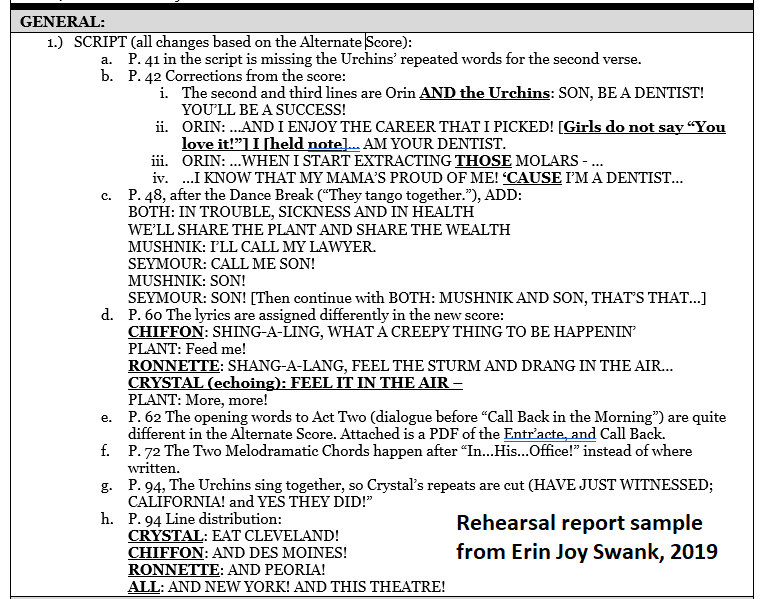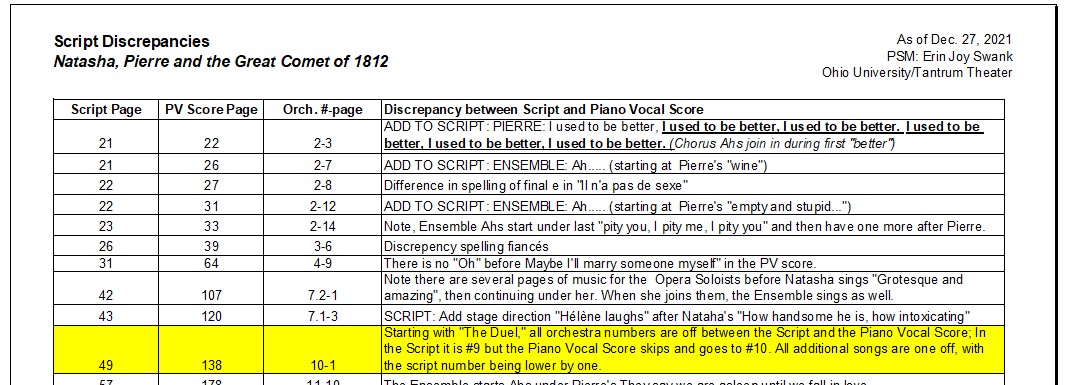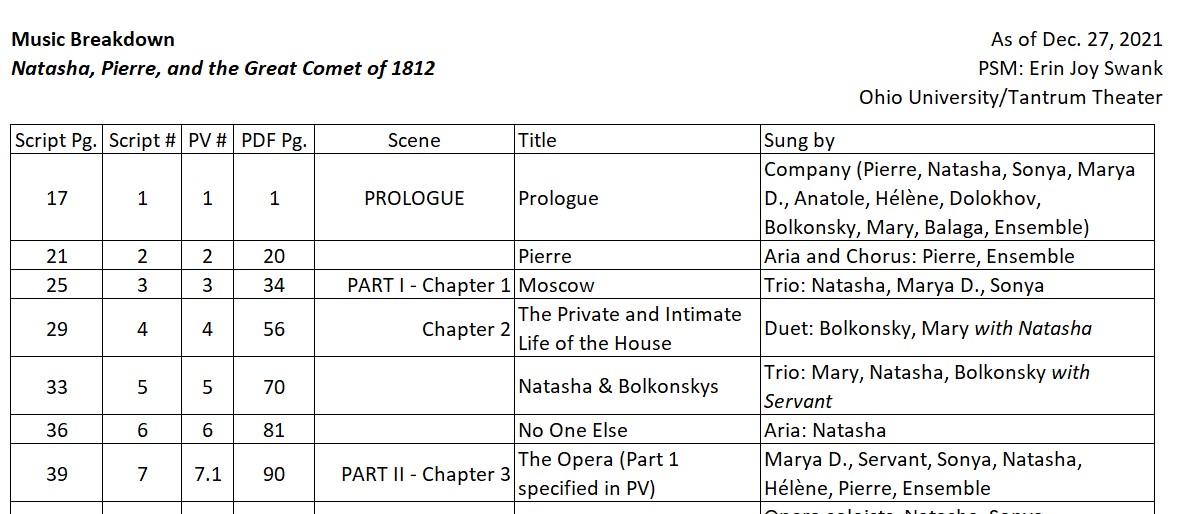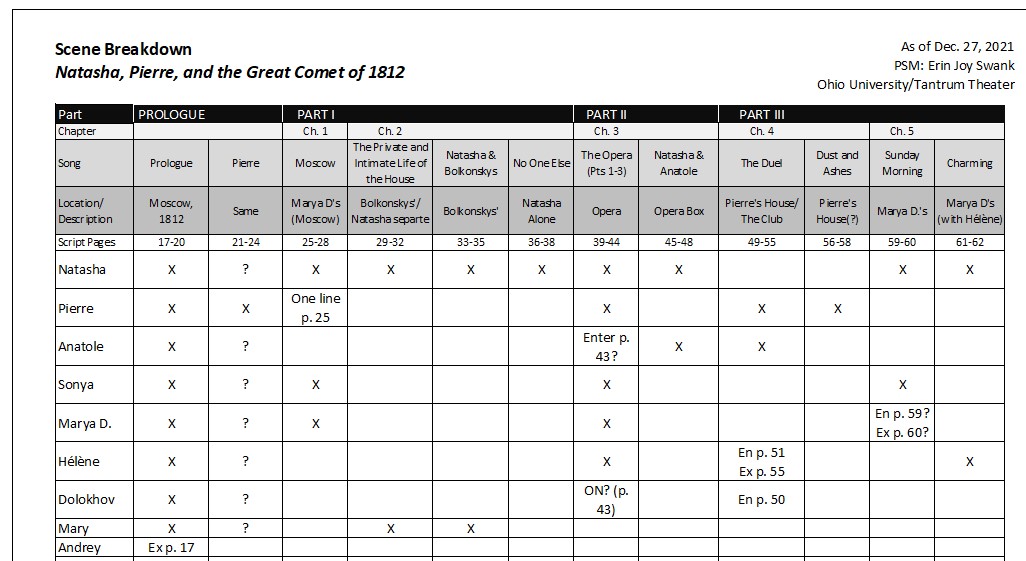I don’t know whether I’m jinxing myself by working on prep for a show yet, given the state of our industry, but I finally started to do so this week. It’s an Equity contract, where I’ll officially be paid one week of prep before rehearsals start. That said, I’ve been given permission to do some of my prep remotely, so will be spending part of that week making the drive from Colorado to Ohio. (I want more flexibility in my travel capabilities while there, especially since it’s only a few hours from my mother and old stomping grounds.) That said, I’m keeping track of my hours to flex the time, and working a little in advance. Also, y’all it’s HARD stepping back into productions during a pandemic. I’d rather give my brain some time to mull around the show and get used to it, without trying to rush it all in 7 days and fight the fatigue. Also, as near as I can figure out, we (Ohio University/Tantrum Theater) are going to be the first ones to produce Natasha, Pierre and the Great Comet of 1812* regionally after Broadway, so it’s not like I can call on a lot of other stage managers’ paperwork or discussions on how they’ve done the show before. Plus, a musical that new makes me wonder how prepped the rental script is. I mean, there are classics out there whose scripts are still in terrible shape after decades of performance rights. Having worked on an original musical, too, you can absolutely understand how the issues arise. [*Note, there is no second/Oxford comma in the title, according to the publishers…]

So, what have I worked on so far?
Early on, I did some digging online and found a bootleg copy of the script and a bootleg video. I followed along with the script while watching, as the audio wasn’t great…….and the two didn’t always match. So yes, if you’re a stage manager, sure, you can investigate if copies of the script are out there in advance, but take it all with a grain of salt until you get the actual rental version. Don’t get married to your page numbers in breakdowns, especially. And in several of my online communities, while people may ask others if they happen to have a digital copy of a script (and especially those coveted editable ones), we encourage others to NEVER PUBLICLY REVEAL if you actually have it to share, or received it from anyone, due to copyright issues. That said, if you are an opera stage manager, I highly recommend checking out IMSLP.org for your scores.
I have now obtained both the script and piano/vocal score reduction from the producers. Given my experience earlier, I decided my next course of action was to make a document comparing the two. When I stage managed Little Shop of Horrors in 2019, there were MAJOR discrepancies between what was in the libretto (text only/script), what the conductor was using (piano/vocal reduction) and the vocal book (what the actors often get in the back of the script). That time, I ended up putting the following into one of the rehearsal reports, for record:

Script Discrepancies
This weekend I posted this image for #StageShotSunday.
View this post on Instagram
Note, my Fire tablet is connected as a second monitor (how-to in this past blog post).
I pulled up the script and piano/vocal (PV) score on my laptop, and created a Google sheet, shown on the second monitor. I was pleasantly surprised that there weren’t such glaring issues as I’d had with Little Shop. Most of the notes I took are where the Ensemble is oohing/ahing under the lead singers, but it isn’t mentioned in the script at all. There are also a few syllable changes that make it easier to sing, that I wouldn’t want someone to “correct” if reading the libretto. I don’t know how many will be following the libretto (because, really, it’s only about 100 pages, whereas the piano/vocal is more than 400), but I want to help them follow along. After doing all of this comparison, I’m strongly leaning towards doing my script from the PV. I could also Frankenscript/Frankenscore it (using a combo of the two), if I have huge sections without cues, but I think I’m also going to have a bunch of cues and the music isn’t completely intuitive as to where beats happen. And this year, even more, I need to set up my script so someone ELSE could come in and cover if needed. Let’s set everyone up for the best – giving the info to those for the libretto, and using the PV for myself.
[EDIT 1/6 regarding the following discussion: Note – I thought about writing another blog post, but…short version, this was NOT the final score I should have worked off….the official rental version fixed this problem and I was going off an older copy.] And then as I got to #26 in the PV, I realized a bigger issue………it was numbered #25 in the script. I eventually went back to discover they went awry at #9. It also absolutely explains what was going on between the video I watched and the original script I found. At some point, Orchestra #9, “Natasha Lost” was CUT from the show. It was still in the script I’d found online. For my rental script, they renumbered the next one, “The Duel,” as #9, but the PV just cut #9 and the same song is #10. Orchestra numbers are something I try to include in my paperwork, because that’s how the orchestra members refer to songs easiest. So next week I’ll be checking with the conductor and/or producer to see what it gives for, say, the cellist. The PV does not have continuous page numbers, but every piece starts over with the orchestra number, so I have a feeling we’ll use the PV numbers. (“The Duel” is pages 10-1 to 10-31, and then the next song starts with 11-1; there is no running tally at the bottom of the page for the entire PV.) So, that was a good thing to discover. [Orchestra numbers/rehearsal numbers are very much used when you’re working on an opera.]

I’m not quite consistent on how I note the missing Ensemble parts, but the meaning is fairly clear. I’ll probably clean it up later. PV Score Page refers to the PDF pagination. I also switched the final to Excel, because I don’t like Google Sheets header/footer options, and I feel pretty thorough, so don’t feel we’ll need to have multiple people edit at the same time.
Music Breakdown
I next decided to work on a docment I tend to make for every musical, a music breakdown. The format can vary for me, especially depending on the size of a cast. When I did Ain’t Misbehavin’, every actor got a column in the document (only 5 total), with a note of whether they were the lead or backup. For this one, there was a song breakdown in the front of the script, and my Adobe Acrobat Pro recognized it as text, so I started by copy/pasting that. The top of each song in the PV also lists who sings the piece, so I compared the two and found the discrepancies. Usually the PV was more correct, except for one number.

At the footer of the document, I typed, “Note: Italics indicate different personnel than listed in front of script (and “Company” is detailed further).” Ah, and looks like that Oxford comma showed up in the title…Also, this musical is a bit odd in the setup, hence keeping the scenes listed in this one, which I might not normally include.
Character/Scene Breakdown
The final document I’ve worked on so far is something I do nearly first on almost every show I do, to wrap my head around the flow. I don’t have possession of the cast list yet, so I’ve started with characters. Eventually, I will include actor names as well, and combine any rows if they play multiple characters. This is a rough version so there are plenty of question marks. I’ve included an X if they are mentioned at all in script, or sing, and if I have any information about an entrance or exit, that is included as well. I use enough formatting that this will likely stay an Excel file, so we’ll have to make sure several of us on the team aren’t updating it at once. I’d normally put the orchestra numbers, but we’ve already discussed my dilemma on that one at the moment.

EDIT/UPDATE: This musical only has one line of dialogue outside the music, so each song gets its own column in this case. For a more traditional musical, here’s how I did Big River‘s character scene breakdown (can also be found on my Portfolio page). In that one, I also show how I delineate a person playing more than one character, and details as I start knowing the location of entrances and exits.
Miscellaneous Additional Prepwork
I’d usually start working on a musical theatre version of opera’s Who/What/Where paperwork at this point, but I think that will need to wait until we start blocking, since this could wind up with people rarely leaving the stage, or constantly leaving the stage. Maybe I’ll make the bones of it, with song titles before too long.
Otherwise, I’m working to seep the music into my brain, by playing the CDs quite a bit. We were given quite a bit of dramaturgy in advance for this show, as it is based on War and Peace. It’s been highly recommended we watch the BBC series from 1972, so we’ll see if I get to that before prep week. I’m also incredibly interested in what COVID protocols and understudy thoughts the producers are thinking, and got information today that they’re planning an internal safety meeting next week. I do keep saying “if” this show happens, given the way of the world of so many shows canceling, closing or going through understudies/swings onstage and off. I certainly hope it does happen, because I’m highly looking forward to working on it. Wish us all luck, safety, and health!
Oh, and for the record, these three documents were about 6 1/2 hours of paperwork for me, split up over several days. I didn’t actually time myself watching the bootleg previously, though it’s about 2:15 online, and I know I paused and backed up going, “Huh?” several times!
Fantastic explanation of this process. Does your director duplicate any of this in their own format? How do you work with them on that?
I’ve found that these particular documents, I want to do on my own and compare with anything anyone else does, but I absolutely will be discussing with the director soon. I want to make sure we call scenes the same things, find out who he’s assigned to anything, etc. And then it’s usually a discussion of whose version to pass along to others, but mine is already in the “Stage Management” file of our production’s Dropbox at the moment. I looked in the Dropbox for any similar docs before I started too, and didn’t see any there. Great questions.
Sometimes my Character/Scene Breakdown will go further to help me visualize the show. When we did Little Women the Musical, with a turntable, I ended up with a row for scenery with which direction the revolve was and whether the “Sliders” were open or closed, and a row for props needed in that scene. I’ll also add any costume notes within an actor’s cell for a scene (removes Hat p. 13 for example, or Ballgown for a scene).